Heidi Latsky Dance shows a new film and two dances at Montclair State University Alexander Kasser Theater, April 16 through 19.
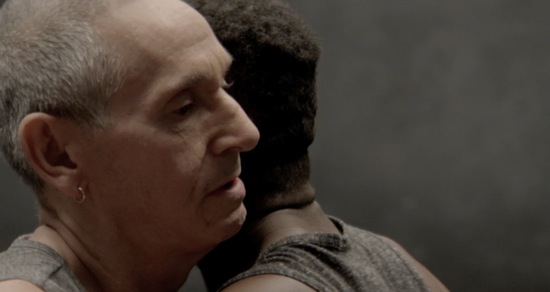
Robert Simpson (L) and Jerron Herman in a still from Heidi Latsky’s film Soliloquy. Photo: Zac Halberd
Ideal beauty has always been a slippery topic, certainly since Plato strolled the streets of Athens. We’re pretty clear about structural archetypes, despite nature’s occasional deviations and breeders’ genetic modifications: sheep are quadrupeds with woolly coats; birds have wings; kangaroos hop. But beauty, most hominids have finally come to realize, is not a one-size-fits-all archetype. Obesity in a woman is admired in the Fiji Islands and elsewhere. The Kayan women of Myanmar wear towers of rings that compress their shoulders and ribcages to create the illusion of a giraffe-like neck. In the latter half of the 19th century in Europe and America, women cinched themselves into corsets to achieve sixteen-inch waist (displacing their innards in the process), and what would be considered emaciation by some segments of society signifies beauty in many ballet companies.
Since 2006, Heidi Latsky’s choreographic work has included The Gimp Project. The word “gimp” can be defined (relevantly in this case) as both a difficult way of walking and (by the Oxford English Dictionary as “fighting spirit”, “vigor”, “interwoven fabric”, “trembling with ecstasy.”
Here is a statement from her company’s website: “The mission of Heidi Latsky Dance is to redefine beauty and virtuosity through performance and discourse, using performers with unique attributes to bring rigorous, passionate and provocative contemporary dance to diverse audiences.” In this case “unique attributes” refers not only the individuality of the dancers with whom she works, but to the fact that some of them have disabilities (she dislikes the negative aura of that word, since it is their abilities that she makes artistic use of).
The program of Heidi Latsky Dance, presented by Peak Performances at Montclair State University offers three diverse, yet fundamentally related pieces. The first of these is a short film, Soliloquy, directed and choreographed by Latsky, that was created during a residency at the campus’s Alexander Kasser Theater, with the assistance of a large roster of collaborators that includes Montclair State students.
The aesthetic that guides much of the film is that of extreme intimacy. At first, what we see projected on a screen that fills the stage’s proscenium arch is mysterious—and beautiful. Arms and hands swirling in and out of focus, a long panning of the camera along surfaces that could be skin or, wait, fabric. A gigantic human eye stares at us. Then the complete image of Lawrence Goldhuber appears on the right of the screen (once, like Latsky, a member of the Bill T. Jones/Arnie Zane Dance Company, and subsequently her much larger dance partner); slowly, and in silence, he lowers one arm. That quiet moment acts as a signal to ignite more rapid, fluid motion. Chris Brierley’s soundscape (plus music) emerges as a distant rumble.
In extreme close-ups, we see heads nuzzling each other; bodies gently, sensuously tangling; tendrils of hair flying in response to motion we can’t fully see; a pregnant belly; a man’s broad, naked back; and more. Sometimes images flash by; at other times the camera rests briefly before moving on. The performers may be moving vigorously in and out of the frame; at other times they rest in place against a dark background, exploring possibilities. Robert Simpson—a dancer who survived a damaging accident and is coping with Parkinson’s Disease—wreathes one arm around his head in an intimate dance of touching, pressing stroking, his face revealing the ardor of the effort.
At the end of the Soliloquy, a full-length portrait appears of each of the ten performers involved, one by one. Just standing there staring at us, as if to say, “This is me; here I am. Take a look.” Here is Alexandra Failes (those lashing black curls were hers, I think). Here is Evan Ruggiero standing on the only flesh-and-blood leg he’s got. We’ve already seen an image of Jen Brick, born without legs, balancing in a handstand (she’s an accomplished acrobat and aerialist).
Dance for Film on Location at Montclair State University will, with funding from The Andrew W. Mellon Foundation, produce two more films over the next two years—one by Nora Chipaumire and one by Doug Elkins. One fine thing about these films is that they, plus supporting documentary materials, will be available—free and on demand—to Montclair State students.
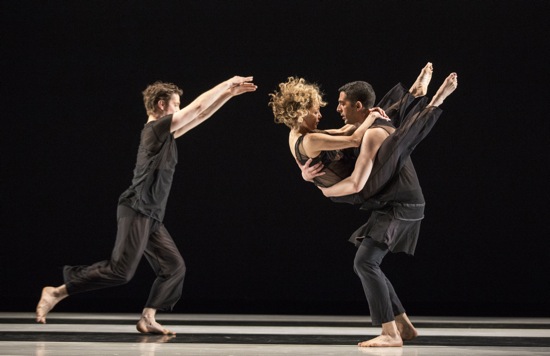
(L to R): Brynt Beitman, Heidi Latsky, and Gregory Youdan Jr. in Latsky’s Solo Countersolo. Photo: Marina Levitskaya
In this program that Latsky has dubbed “Tryptich,” the central work is her Solo Countersolo. She herself is a dynamo—small, nimble and agile, and it’s not surprising that one aspect of her creative work indulges her appetite for unrestricted movement. She begins this 2013 work as the central figure embedded in a group of five (Brynt Beitman, Meredith Fages, Jillian Hollis, Saki Masuda, and Gregory Youdan Jr). Wearing black costumes by Carlos Arias, these others are in shadow, lined up at the back of the stage when Latsky moves forward into Robert Wierzel’s fine, subtly dramatic lighting.
Rising and sinking, bending over, swaying her hips or lashing her arms, she might be a motor powering the others to change a facing or take a step in a new direction. A driving pulse that can also changes its quality underlies Brierley’s splendid score, which at times—in its own way— evokes music of the Baroque period, The choreography for Solo Countersolo elegantly juxtaposes Latsky to the three other women and to the two men. She may join the women or hurtle between the men but she returns to her own soliloquy or threads it among them. Except for the dancers’ one-step-at-a-time exits (they make me think of pieces on a board game), the piece is grounded in high-energy passages of dancing, whose style is both eclectic and personal. Some of the steps allude to ballet’s pirouettes, ballonées, and arabesques), but these are loosened and presented without fanfare as elements of vibrant, ongoing, multi-dimensional human traffic. Pale, horizontal strips become highways for the performers’ travels.
The choreography gives you chances to focus on individuals—all of whom have extensive backgrounds in other companies beside Latsky’s: red-haired Hollis moves voluptuously, powerfully. Fages has performed in ballets, and her legs slice the air with articulate ease. Latsky and Masuda, holding hands like two skaters, crossing the stage with peppy footwork; Beitman and Youdan cut through the space, their intricately designed jumping passages executed in perfect synchrony.
In one sequence, the cast lines up across the stage—every other person performing one phrase, and the people between them another. But Latsky keeps re-examining her initial pattern or varying it; the dynamo who set this dance in motion lets it absorb and reinvigorate her. If the lights suddenly went out, you imagine that her movements could power them up again.
Latsky credits the dancers as collaborators in both Solo Countersolo and in the 2015 Somewhere. This new dance features the above-mentioned six (including herself) and adds Jerron Herman, John McGinty, Alexandria Wailes, and Simpson. The performers scattered onstage at the beginning lift their arms, tilt to the side, then freeze. Dressed in white clothes, they come to life again and thrash those arms around, twist their bodies, and become motionless again. This is a rhythm that will recur through the dance; at times, the still figures resemble trees in a forest that others pass through or rouse into life. Tiny lights on long wire descend from above, as more dancers enter, one by one. A bulb upstage left begins to glow as Simpson walks joltingly yet firmly across the stage and sits on a chair. He is placed downstage of that light, facing away from us, so we see only that he sometimes bends over or raises one long arm like a wing; you can imagine that he’s conducting whoever lingers in the space in front of him.
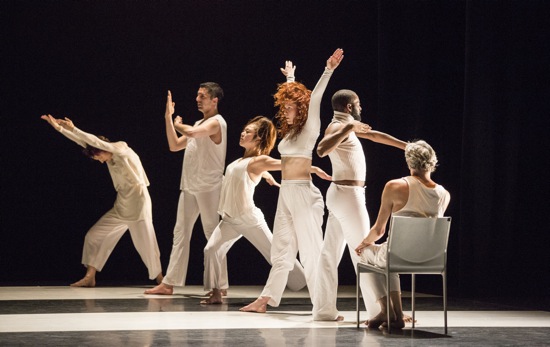
Heidi Latsky’s Somewhere. (L to R) Meredith Fages, Gregory Youdan Jr., Saki Masuda, Jillian Hollis, Jerron Herman, and Robert Simpson. Photo by Marina Levitskaya
Eventually all the small lights are glowing, and the original music by Xi.me.na Borges is playing. In her intriguing score, you can hear low rumbling, two sounds jostling together, a thudding march, pulsing and eventually distant voices singing. And you can note how masterfully Latsky and the dancers accommodate to one another’s strengths and weaknesses as they mingle. McGinty and Wailes dance side by side, their arm movements bold, their wide-legged steps forward powerful. When McGinty leaves, Wailes sits down and makes lovely fluid gestures toward Simpson that, regardless of their significance in American sign language, dance. Meanwhile Herman and Hollis are embracing centerstage, their arms curling around each other, yet not always touching.
A beautiful example of how Latsky creates for and with her dancers comes when Herman and Youdan dance assertively in side-by-side unison. You may or may not have noticed that Herman, a vivid presence onstage, can’t fully articulate his left arm. It wants to stay in certain positions away from his body, sometimes out to the side or front, the hand curled. So Youdan uses his left arm in the same way, and together, the two men perform a fine duet that reveals, yet also conceals, and certainly triumphs over Herman’s compromised relationship to his arm.
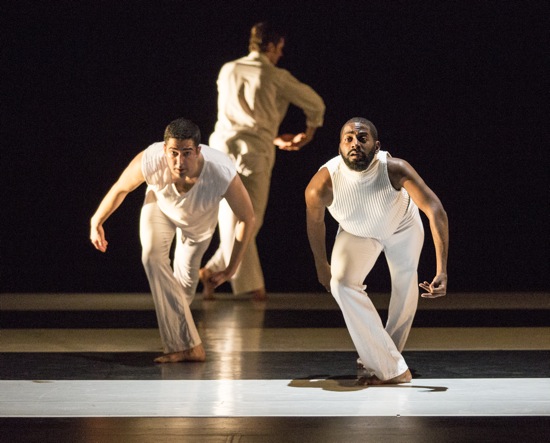
(L to R): Gregory Youdan Jr., Brynt Beitman, and Jerron Herman in Somewhere. Photo: Marina Levitskaya
The harmony among these Latsky and these performers and among themselves, as well as what they have achieved in terms of art is a beautiful thing to see. Each person stimulates the others and is honored and, yes, cherished for all that he or she can contribute. Watching all of them at work can make one both more accepting of one’s own limitations and impatient to get on with the business of challenging these.

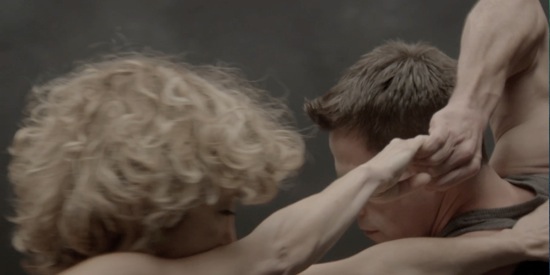
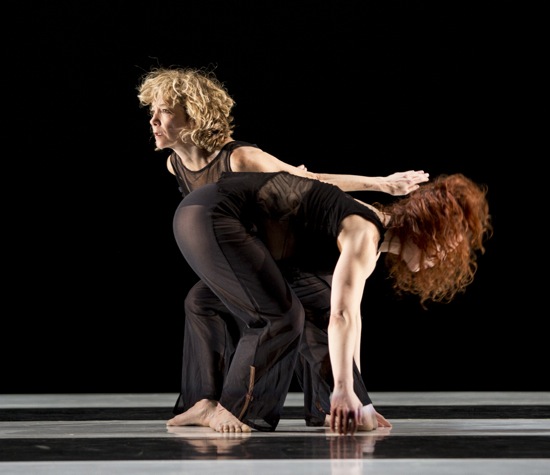
Deborah,
Always and forever my favorite translator in turning movement and its meanings into the written word…thanks for coming and writing about Heidi’s newest endeavor!
Always makes me smile to see you in the audience., especially when it’s a production I am involved in because I know it will get a heartfelt assesment and I usually end up learning/seeing something new!
Best, Jeremy
Having dabbled a little in ballet when I was young, then losing interest and also giving it up because I began to understand that a career in ballet meant to “ruin” one’s feet (that’s still how I can’t help seeing it), I noticed of late that many of the modern choreographies become more and more acrobatic and “excentric” and I wonder how, while delivered gracefully, today’s dancers cope with this general ravaging of their bodies that I have seen when I was “in the industry”. Certainly it attests to the addictiveness of the undertaking if people dedicate their lives to artistic dance.